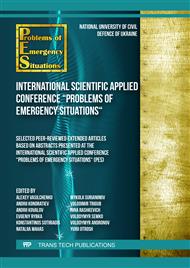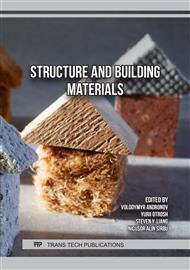[1]
V.P. Sopov, A.L. Tkachuk, Vliyanie mineralnyh dobavok na strukturoobrazovanie cementnogo kamnya. Naukovij visnik budivnictva, 66 (2011) 250–254 [in Russian].
Google Scholar
[2]
А. Shishkin, N. Netesa, А. Netesa, Determining the rational compositions of low-strength concretes. Eastern-European Journal of Enterprise Technologies, 1(6–97) (2019) 47–52.
DOI: 10.15587/1729-4061.2019.156599
Google Scholar
[3]
M.N Moroz., V.I Kalashnikov., V.A. Hudyakov, P.G. Vasilik, Vodostojkij melkozernistyj beton, gidrofobizirovannyj nanochasticami stearata kalciya. Stroitelnye materialy, 8 (2009) 55–59 [in Russian].
Google Scholar
[4]
A.V. Nomoev, V.C. Lygdenov, L.A. Urhanova, S.A. Lhasaranov, Melkozernistyj cementnyj beton s nanodispersnym modifikatorom. Nanotehnologii v stroitelstve: nauchnyj internet-zhurnal, 4 (2010) 42–52 [in Russian].
Google Scholar
[5]
A.I. Hristoforov, I.A. Hristoforova, D.I. Kuzmin, Melkozernistyj beton, modificirovannyj organicheskimi soedineniyami Na+. Stroitelstvo i rekonstrukciya, 2 (2011) 104–109 [in Russian].
Google Scholar
[6]
A. Shishkina, A. Shishkin, Research into effect of complex nanomodifiers on the strength of fine-grained concrete. Eastern-European Journal of Enterprise Technologies, 2(6–92) (2018) 29–33.
DOI: 10.15587/1729-4061.2018.127261
Google Scholar
[7]
V. Ramachandran, Concrete admixtures handbook. Propertles, Science, and Technology. Edited by V. Ramachandran. Noyes publications. Park Ridge. New Jergey. USA. (1988) 575.
Google Scholar
[8]
V.S. Yzotov, N.N. Morozova, Korrozyonnaia stoikost betonov na smeshannom viazhushchem. Yzv. Vuzov. Stroytelstvo, 12 (1997) 50–52 [in Russian].
Google Scholar
[9]
O.O. Shishkina, O.O. Shishkin, Doslidzhennya vplivu nanokatalizu na formuvannya micnosti reakcijnogo poroshkovogo betonu. Eastern-European Journal of Enterprise Technologies, 1(6–79) (2016) 55–60.
Google Scholar
[10]
B.V. Deryagin Itogi issledovaniya svoistv granichnikh sloev zhidkostei i ikh rol v ustoichivosti dispersnikh sistem. Uspekhi kolloidnoi khimii, (1973) 30–38 [in Russian].
Google Scholar
[11]
C.C.D Coumes, M. Dhoury, J.B. Champenois, C. Mercier, D. Damidot, Physicochemical mechanisms involved in the acceleration of the hydration of calcium sulfoaluminate cement by lithium ions. Cement and Concrete Research, 96 (2017) 42–51.
DOI: 10.1016/j.cemconres.2017.03.004
Google Scholar
[12]
D. Marchon, R.J. Flatt, Mechanisms of cement hydration. Science and Technology of Concrete Admixtures. (2016) 129–145.
DOI: 10.1016/b978-0-08-100693-1.00008-4
Google Scholar



